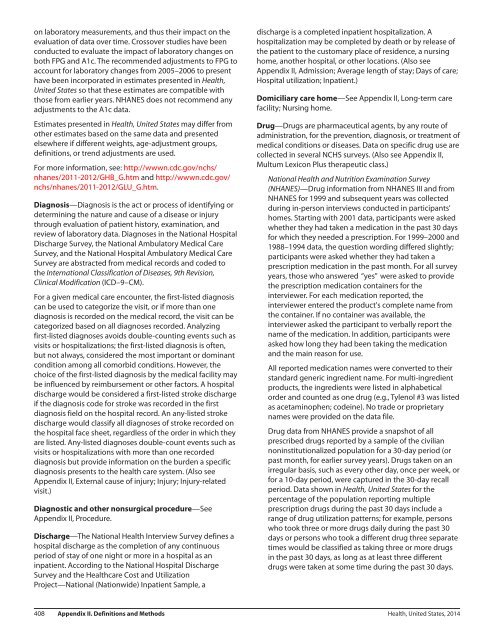hus14
hus14
hus14
You also want an ePaper? Increase the reach of your titles
YUMPU automatically turns print PDFs into web optimized ePapers that Google loves.
on laboratory measurements, and thus their impact on the<br />
evaluation of data over time. Crossover studies have been<br />
conducted to evaluate the impact of laboratory changes on<br />
both FPG and A1c. The recommended adjustments to FPG to<br />
account for laboratory changes from 2005–2006 to present<br />
have been incorporated in estimates presented in Health,<br />
United States so that these estimates are compatible with<br />
those from earlier years. NHANES does not recommend any<br />
adjustments to the A1c data.<br />
Estimates presented in Health, United States may differ from<br />
other estimates based on the same data and presented<br />
elsewhere if different weights, age-adjustment groups,<br />
definitions, or trend adjustments are used.<br />
For more information, see: http://wwwn.cdc.gov/nchs/<br />
nhanes/2011-2012/GHB_G.htm and http://wwwn.cdc.gov/<br />
nchs/nhanes/2011-2012/GLU_G.htm.<br />
Diagnosis—Diagnosis is the act or process of identifying or<br />
determining the nature and cause of a disease or injury<br />
through evaluation of patient history, examination, and<br />
review of laboratory data. Diagnoses in the National Hospital<br />
Discharge Survey, the National Ambulatory Medical Care<br />
Survey, and the National Hospital Ambulatory Medical Care<br />
Survey are abstracted from medical records and coded to<br />
the International Classification of Diseases, 9th Revision,<br />
Clinical Modification (ICD–9–CM).<br />
For a given medical care encounter, the first-listed diagnosis<br />
can be used to categorize the visit, or if more than one<br />
diagnosis is recorded on the medical record, the visit can be<br />
categorized based on all diagnoses recorded. Analyzing<br />
first-listed diagnoses avoids double-counting events such as<br />
visits or hospitalizations; the first-listed diagnosis is often,<br />
but not always, considered the most important or dominant<br />
condition among all comorbid conditions. However, the<br />
choice of the first-listed diagnosis by the medical facility may<br />
be influenced by reimbursement or other factors. A hospital<br />
discharge would be considered a first-listed stroke discharge<br />
if the diagnosis code for stroke was recorded in the first<br />
diagnosis field on the hospital record. An any-listed stroke<br />
discharge would classify all diagnoses of stroke recorded on<br />
the hospital face sheet, regardless of the order in which they<br />
are listed. Any-listed diagnoses double-count events such as<br />
visits or hospitalizations with more than one recorded<br />
diagnosis but provide information on the burden a specific<br />
diagnosis presents to the health care system. (Also see<br />
Appendix II, External cause of injury; Injury; Injury-related<br />
visit.)<br />
Diagnostic and other nonsurgical procedure—See<br />
Appendix II, Procedure.<br />
Discharge—The National Health Interview Survey defines a<br />
hospital discharge as the completion of any continuous<br />
period of stay of one night or more in a hospital as an<br />
inpatient. According to the National Hospital Discharge<br />
Survey and the Healthcare Cost and Utilization<br />
Project—National (Nationwide) Inpatient Sample, a<br />
discharge is a completed inpatient hospitalization. A<br />
hospitalization may be completed by death or by release of<br />
the patient to the customary place of residence, a nursing<br />
home, another hospital, or other locations. (Also see<br />
Appendix II, Admission; Average length of stay; Days of care;<br />
Hospital utilization; Inpatient.)<br />
Domiciliary care home—See Appendix II, Long-term care<br />
facility; Nursing home.<br />
Drug—Drugs are pharmaceutical agents, by any route of<br />
administration, for the prevention, diagnosis, or treatment of<br />
medical conditions or diseases. Data on specific drug use are<br />
collected in several NCHS surveys. (Also see Appendix II,<br />
Multum Lexicon Plus therapeutic class.)<br />
National Health and Nutrition Examination Survey<br />
(NHANES)—Drug information from NHANES III and from<br />
NHANES for 1999 and subsequent years was collected<br />
during in-person interviews conducted in participants'<br />
homes. Starting with 2001 data, participants were asked<br />
whether they had taken a medication in the past 30 days<br />
for which they needed a prescription. For 1999–2000 and<br />
1988–1994 data, the question wording differed slightly;<br />
participants were asked whether they had taken a<br />
prescription medication in the past month. For all survey<br />
years, those who answered ‘‘yes’’ were asked to provide<br />
the prescription medication containers for the<br />
interviewer. For each medication reported, the<br />
interviewer entered the product's complete name from<br />
the container. If no container was available, the<br />
interviewer asked the participant to verbally report the<br />
name of the medication. In addition, participants were<br />
asked how long they had been taking the medication<br />
and the main reason for use.<br />
All reported medication names were converted to their<br />
standard generic ingredient name. For multi-ingredient<br />
products, the ingredients were listed in alphabetical<br />
order and counted as one drug (e.g., Tylenol #3 was listed<br />
as acetaminophen; codeine). No trade or proprietary<br />
names were provided on the data file.<br />
Drug data from NHANES provide a snapshot of all<br />
prescribed drugs reported by a sample of the civilian<br />
noninstitutionalized population for a 30-day period (or<br />
past month, for earlier survey years). Drugs taken on an<br />
irregular basis, such as every other day, once per week, or<br />
for a 10-day period, were captured in the 30-day recall<br />
period. Data shown in Health, United States for the<br />
percentage of the population reporting multiple<br />
prescription drugs during the past 30 days include a<br />
range of drug utilization patterns; for example, persons<br />
who took three or more drugs daily during the past 30<br />
days or persons who took a different drug three separate<br />
times would be classified as taking three or more drugs<br />
in the past 30 days, as long as at least three different<br />
drugs were taken at some time during the past 30 days.<br />
408 Appendix II. Definitions and Methods Health, United States, 2014


